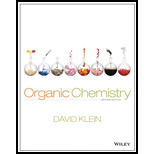
(a)
Interpretation:
The name of the Parent chain for the given compound should be identified.
Concept introduction:
Parent chain is the longest chain of a compound. If there are two longest chains, the more substituted chain is the parent chain.
Name for the
| Number of carbon atoms | Name of parent alkane |
| 1 | methane |
| 2 | ethane |
| 3 | propane |
| 4 | butane |
| 5 | Pentane |
| 6 | hexane |
| 7 | Heptane |
| 8 | octane |
| 9 | nonane |
| 10 | decane |
(a)
Answer to Problem 39PP
Octane
Explanation of Solution
The longest chain of the given compounds is identified by counting the number of carbon atoms presented in each chain of a compound. Longest chain is the carbon skeleton of a molecule that contains more number of carbons.
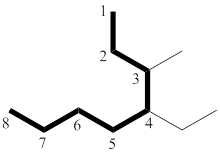
The longest chain has eight carbon atoms. By referring the above table, deduce the name as octane for parent chain.
(b)
Interpretation:
The name of the Parent chain for given compounds should be identified.
Concept introduction:
Parent chain is the longest chain of a compound. If there are two longest chains, the more substituted chain is the parent chain.
Name for the alkane parent chain depends on the number of carbon atoms present in the longest continuous carbon chain.
| Number of carbon atoms | Name of parent alkane |
| 1 | methane |
| 2 | ethane |
| 3 | propane |
| 4 | butane |
| 5 | Pentane |
| 6 | hexane |
| 7 | Heptane |
| 8 | octane |
| 9 | nonane |
| 10 | decane |
(b)
Answer to Problem 39PP
Nonane
Explanation of Solution
The longest chain of the given compounds is identified by counting the number of carbon atoms presented in each chain of a compound. Longest chain is the carbon skeleton of a molecule that contains more number of carbons.
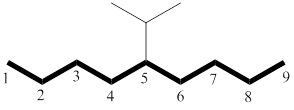
The longest chain has nine carbon atoms. By referring the above table, deduce the name as nonane for parent chain.
(c)
Interpretation:
The name of the Parent chain for given compounds should be identified.
Concept introduction:
Parent chain is the longest chain of a compound. If there are two longest chains, the more substituted chain is the parent chain.
Name for the alkane parent chain depends on the number of carbon atoms present in the longest continuous carbon chain.
| Number of carbon atoms | Name of parent alkane |
| 1 | methane |
| 2 | ethane |
| 3 | propane |
| 4 | butane |
| 5 | Pentane |
| 6 | hexane |
| 7 | Heptane |
| 8 | octane |
| 9 | nonane |
| 10 | decane |
(c)
Answer to Problem 39PP
Octane
Explanation of Solution
The longest chain of the given compounds is identified by counting the number of carbon atoms presented in each chain of a compound. Longest chain is the carbon skeleton of a molecule that contains more number of carbons.
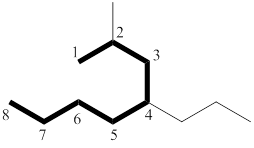
Here there are two longest chain of carbon atoms presented. But one has one substituent and other has two substituents. So the two substituted longest chain is the parent chain.
The longest chain has eight carbon atoms. By referring the above table, deduce the name as octane for parent chain.
(d)
Interpretation:
The name of the Parent chain for given compounds should be identified.
Concept introduction:
Parent chain is the longest chain of a compound. If there are two longest chains, the more substituted chain is the parent chain.
Name for the alkane parent chain depends on the number of carbon atoms present in the longest continuous carbon chain.
| Number of carbon atoms | Name of parent alkane |
| 1 | methane |
| 2 | ethane |
| 3 | propane |
| 4 | butane |
| 5 | Pentane |
| 6 | hexane |
| 7 | Heptane |
| 8 | octane |
| 9 | nonane |
| 10 | decane |
(d)
Answer to Problem 39PP
Heptane
Explanation of Solution
The longest chain of the given compounds is identified by counting the number of carbon atoms presented in each chain of a compound. Longest chain is the carbon skeleton of a molecule that contains more number of carbons.
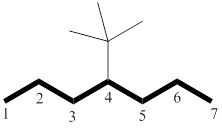
The longest chain has seven carbon atoms. By referring the above table, deduce the name as heptane for parent chain.
Want to see more full solutions like this?
Chapter 4 Solutions
Organic Chemistry
- 8:17 PM Sun Mar 30 Draw the major product of this reaction. Ignore inorganic byproducts. HSCH2CH2CH2SH, BF3 Probler Drawing Ato Bonds Clarrow_forwardpresented by Mr L How the coprion. (Il Done in no wraction, dew the starting redential) доarrow_forward8:16 PM Sun Mar 30 K Draw the major product of this reaction. Ignore inorganic byproducts. Proble 1. CH3MgBr 2. H3O+ F Drawingarrow_forward
- о но оarrow_forwardName the major organic product of the following action of 4-chloro-4-methyl-1-pentanol in neutral pollution 10+ Now the product. The product has a molecular formula f b. In a singly hain, the starting, material again converts into a secule with the molecular kormula CIO. but with comply Draw the major organic structure inhalationarrow_forwardMacmillan Learning Alcohols can be oxidized by chromic acid derivatives. One such reagent is pyridinium chlorochromate, (C,H,NH*)(CICTO3), commonly known as PCC. Draw the proposed (neutral) intermediate and the organic product in the oxidation of 1-butanol by PCC when carried out in an anhydrous solvent such as CH₂C₁₂. PCC Intermediate OH CH2Cl2 Draw the intermediate. Select Draw Templates More с H Cr о Product Draw the product. Erase Select Draw Templates More H о Erasearrow_forward
- If I have 1-bromopropene, to obtain compound A, I have to add NaOH and another compound. Indicate which compound that would be. A C6H5 CH3arrow_forwardProvide the reagents for the following reactions.arrow_forwardIf I have 1-bromopropene, to obtain compound Z, I have to add two compounds A1 and A2. Indicate which compounds are needed. P(C6H5)3arrow_forward
- Draw the major product of this reaction. Ignore inorganic byproducts. Assume that the water side product is continuously removed to drive the reaction toward products. O CH3CH2NH2, TSOH Select to Draw >arrow_forwardPredict the major organic product(s) for the following reaction.arrow_forwardPredict the major organic product(s) for the following reactions.arrow_forward
 ChemistryChemistryISBN:9781305957404Author:Steven S. Zumdahl, Susan A. Zumdahl, Donald J. DeCostePublisher:Cengage Learning
ChemistryChemistryISBN:9781305957404Author:Steven S. Zumdahl, Susan A. Zumdahl, Donald J. DeCostePublisher:Cengage Learning ChemistryChemistryISBN:9781259911156Author:Raymond Chang Dr., Jason Overby ProfessorPublisher:McGraw-Hill Education
ChemistryChemistryISBN:9781259911156Author:Raymond Chang Dr., Jason Overby ProfessorPublisher:McGraw-Hill Education Principles of Instrumental AnalysisChemistryISBN:9781305577213Author:Douglas A. Skoog, F. James Holler, Stanley R. CrouchPublisher:Cengage Learning
Principles of Instrumental AnalysisChemistryISBN:9781305577213Author:Douglas A. Skoog, F. James Holler, Stanley R. CrouchPublisher:Cengage Learning Organic ChemistryChemistryISBN:9780078021558Author:Janice Gorzynski Smith Dr.Publisher:McGraw-Hill Education
Organic ChemistryChemistryISBN:9780078021558Author:Janice Gorzynski Smith Dr.Publisher:McGraw-Hill Education Chemistry: Principles and ReactionsChemistryISBN:9781305079373Author:William L. Masterton, Cecile N. HurleyPublisher:Cengage Learning
Chemistry: Principles and ReactionsChemistryISBN:9781305079373Author:William L. Masterton, Cecile N. HurleyPublisher:Cengage Learning Elementary Principles of Chemical Processes, Bind...ChemistryISBN:9781118431221Author:Richard M. Felder, Ronald W. Rousseau, Lisa G. BullardPublisher:WILEY
Elementary Principles of Chemical Processes, Bind...ChemistryISBN:9781118431221Author:Richard M. Felder, Ronald W. Rousseau, Lisa G. BullardPublisher:WILEY





